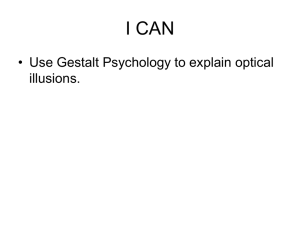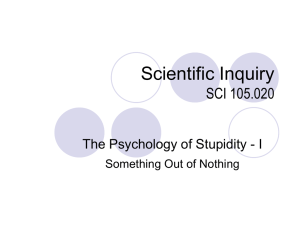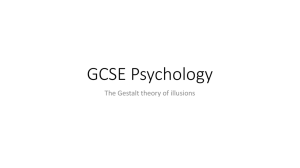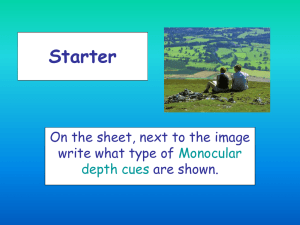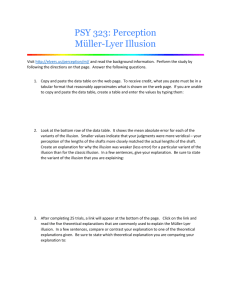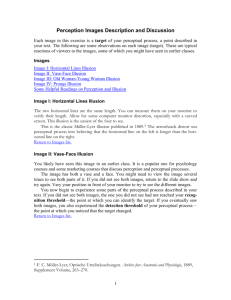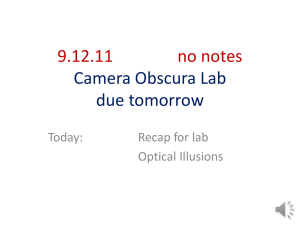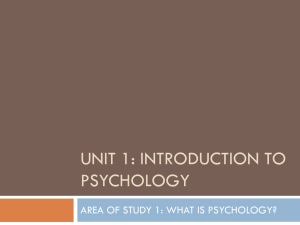Perceptual illusions and brain models
advertisement
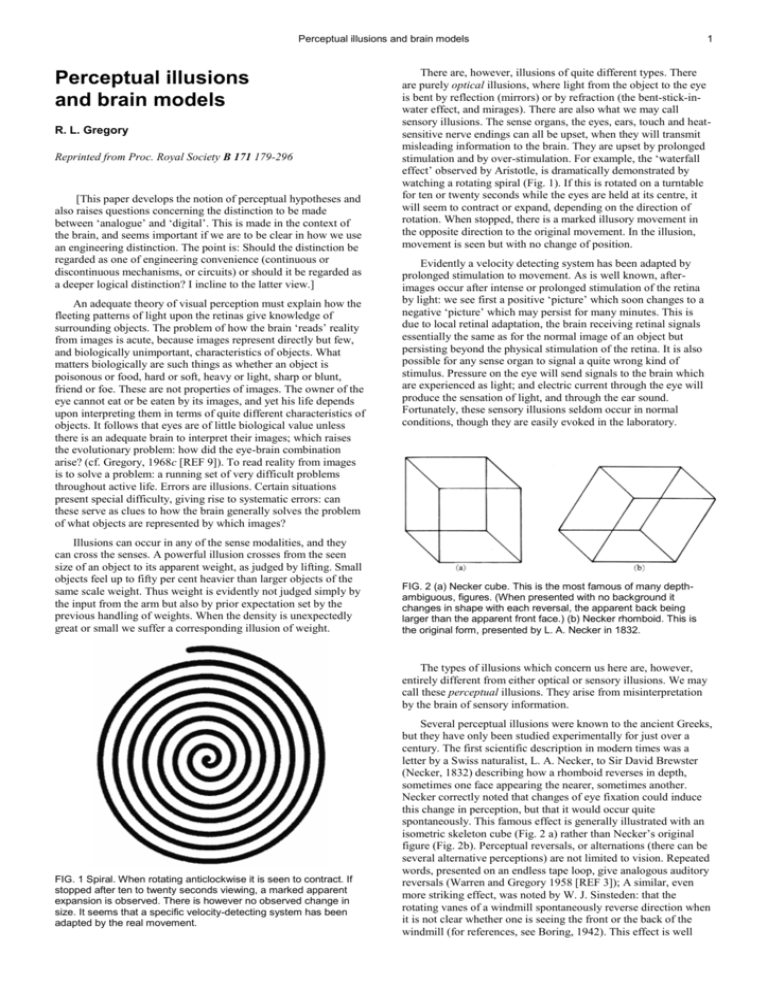
Perceptual illusions and brain models
Perceptual illusions
and brain models
R. L. Gregory
Reprinted from Proc. Royal Society B 171 179-296
[This paper develops the notion of perceptual hypotheses and
also raises questions concerning the distinction to be made
between ‘analogue’ and ‘digital’. This is made in the context of
the brain, and seems important if we are to be clear in how we use
an engineering distinction. The point is: Should the distinction be
regarded as one of engineering convenience (continuous or
discontinuous mechanisms, or circuits) or should it be regarded as
a deeper logical distinction? I incline to the latter view.]
An adequate theory of visual perception must explain how the
fleeting patterns of light upon the retinas give knowledge of
surrounding objects. The problem of how the brain ‘reads’ reality
from images is acute, because images represent directly but few,
and biologically unimportant, characteristics of objects. What
matters biologically are such things as whether an object is
poisonous or food, hard or soft, heavy or light, sharp or blunt,
friend or foe. These are not properties of images. The owner of the
eye cannot eat or be eaten by its images, and yet his life depends
upon interpreting them in terms of quite different characteristics of
objects. It follows that eyes are of little biological value unless
there is an adequate brain to interpret their images; which raises
the evolutionary problem: how did the eye-brain combination
arise? (cf. Gregory, 1968c [REF 9]). To read reality from images
is to solve a problem: a running set of very difficult problems
throughout active life. Errors are illusions. Certain situations
present special difficulty, giving rise to systematic errors: can
these serve as clues to how the brain generally solves the problem
of what objects are represented by which images?
Illusions can occur in any of the sense modalities, and they
can cross the senses. A powerful illusion crosses from the seen
size of an object to its apparent weight, as judged by lifting. Small
objects feel up to fifty per cent heavier than larger objects of the
same scale weight. Thus weight is evidently not judged simply by
the input from the arm but also by prior expectation set by the
previous handling of weights. When the density is unexpectedly
great or small we suffer a corresponding illusion of weight.
1
There are, however, illusions of quite different types. There
are purely optical illusions, where light from the object to the eye
is bent by reflection (mirrors) or by refraction (the bent-stick-inwater effect, and mirages). There are also what we may call
sensory illusions. The sense organs, the eyes, ears, touch and heatsensitive nerve endings can all be upset, when they will transmit
misleading information to the brain. They are upset by prolonged
stimulation and by over-stimulation. For example, the ‘waterfall
effect’ observed by Aristotle, is dramatically demonstrated by
watching a rotating spiral (Fig. 1). If this is rotated on a turntable
for ten or twenty seconds while the eyes are held at its centre, it
will seem to contract or expand, depending on the direction of
rotation. When stopped, there is a marked illusory movement in
the opposite direction to the original movement. In the illusion,
movement is seen but with no change of position.
Evidently a velocity detecting system has been adapted by
prolonged stimulation to movement. As is well known, afterimages occur after intense or prolonged stimulation of the retina
by light: we see first a positive ‘picture’ which soon changes to a
negative ‘picture’ which may persist for many minutes. This is
due to local retinal adaptation, the brain receiving retinal signals
essentially the same as for the normal image of an object but
persisting beyond the physical stimulation of the retina. It is also
possible for any sense organ to signal a quite wrong kind of
stimulus. Pressure on the eye will send signals to the brain which
are experienced as light; and electric current through the eye will
produce the sensation of light, and through the ear sound.
Fortunately, these sensory illusions seldom occur in normal
conditions, though they are easily evoked in the laboratory.
FIG. 2 (a) Necker cube. This is the most famous of many depthambiguous, figures. (When presented with no background it
changes in shape with each reversal, the apparent back being
larger than the apparent front face.) (b) Necker rhomboid. This is
the original form, presented by L. A. Necker in 1832.
The types of illusions which concern us here are, however,
entirely different from either optical or sensory illusions. We may
call these perceptual illusions. They arise from misinterpretation
by the brain of sensory information.
FIG. 1 Spiral. When rotating anticlockwise it is seen to contract. If
stopped after ten to twenty seconds viewing, a marked apparent
expansion is observed. There is however no observed change in
size. It seems that a specific velocity-detecting system has been
adapted by the real movement.
Several perceptual illusions were known to the ancient Greeks,
but they have only been studied experimentally for just over a
century. The first scientific description in modern times was a
letter by a Swiss naturalist, L. A. Necker, to Sir David Brewster
(Necker, 1832) describing how a rhomboid reverses in depth,
sometimes one face appearing the nearer, sometimes another.
Necker correctly noted that changes of eye fixation could induce
this change in perception, but that it would occur quite
spontaneously. This famous effect is generally illustrated with an
isometric skeleton cube (Fig. 2 a) rather than Necker’s original
figure (Fig. 2b). Perceptual reversals, or alternations (there can be
several alternative perceptions) are not limited to vision. Repeated
words, presented on an endless tape loop, give analogous auditory
reversals (Warren and Gregory 1958 [REF 3]); A similar, even
more striking effect, was noted by W. J. Sinsteden: that the
rotating vanes of a windmill spontaneously reverse direction when
it is not clear whether one is seeing the front or the back of the
windmill (for references, see Boring, 1942). This effect is well
Perceptual illusions and brain models
shown by casting the shadow of a slowly rotating vane upon a
screen, thus removing all information of which is the back and
which the front. The shadow will also at times appear to expand
and contract upon the plane of the screen. It is important to note
that these effects are not perceptual distortions of the retinal
image: they are alternative interpretations of the image, in terms of
possible objects, and only one interpretation is correct.
The most puzzling visual illusions are systematic distortions
of size or shape. These distortions occur in many quite simple
figures; the distortions occurring in the same directions and to
much the same extent in virtually all human observers and
probably also in many animals. Their explanation presents a
challenge which should be accepted, for a viable theory of normal
perception must account for them and they could be important
clues to basic perceptual processes.
The simplest distortion illusion was the first to be described:
by the father of experimental psychology, Wilhelm Wundt
(1832—1920), who was Hermann von Helmholtz’s assistant at
Heidelburg. Wundt described the ‘horizontal—vertical’ illusion —
that a vertical line looks longer than the horizontal line of equal
length. He attributed this distortion to asymmetry of the eye
movement system. Although this has been invoked many times
since to explain distortion illusions it must be ruled out, for the
distortions occur in after-images, or in normal retinal images
optically stabilized so as to remain stationary on the eye though it
moves. In addition, distortions can occur in several directions at
the same time, which could hardly be due to eye movements; and
in any case it is difficult to see how curvature distortions could be
related to eye movements. All the evidence points to the origin of
the distortions being not in the eyes but in the brain.
FIG. 3 The Poggendorff illusion figure (1860). The straight line
crossing the rectangle appears displaced.
FIG. 4 (a) Hering illusion (1861) The straight parallel lines appear
bowed outwards. (b) Wundt’s variant of the Hering illusion: the
parallel lines appear bowed inwards (1896).
2
Interest in the illusions became general upon the publication of
several figures showing distortions which could produce errors in
using optical instruments. This concerned physicists and
astronomers a hundred years ago, when photographic and other
ways of avoiding visual errors were not available. The first of the
special distortion figures was the Poggendorff figure of 1860 (Fig.
3). This was followed by the Hering illusion (1861); its converse
being devised by Wundt much later, in 1896 (Thiéry 1896) (FIG.
4). The most famous illusion of all is the Müller-Lyer arrow figure
(FIG. 5). This was devised by F. C. Müller-Lyer and was first
presented in fifteen variants (Müller-Lyer, 1889). This figure is so
simple, and the distortion so compelling that it was immediately
accepted as the primary target for theory and experiment. All sorts
of theories were advanced: Wundt’s eye movement theory (in
spite of its inadequacy); that the ‘wings’ of the arrow heads drew
attention away from the ends of the central line, or ‘arrow shaft’,
to make it expand or contract; that the heads induced a state of
empathy in the observer (though the distortion seems far too
constant for such an explanation), that the distortion is a special
case of a supposed general principle that acute angles tend to be
overestimated and obtuse angles underestimated.
FIG. 5 Müller-Lyer arrows figure 1889. The most famous illusion:
the outward-going 'arrow heads’ produce expansion of the ‘shaft’
and the inward-going heads contraction.
This was, however, left unexplained, and it is not clear why it
should produce size changes without apparent changes of angle.
All these theories had a common feature: they were attempts to
explain the distortion in terms of the stimulus pattern without
reference to its significance in terms of the perception of objects.
There was, however, one quite different suggestion made by A.
Thiéry (1896) that the distortions are related to perspective depth
features. Thiéry regarded the Müller-Lyer arrows as drawings of
such objects as a saw-horse, seen in three dimensions, with the
legs going away from the observer in the acute-angled figure and
towards him in the obtuse-angled figure. This suggestion has
seldom been considered until recently, though the ‘perspective
theory’ was described by R. H. Woodworth in 1938: ‘In the
Müller-Lyer figure the obliques readily suggest perspective and if
this is followed one of the vertical lines appears farther away and
therefore objectively longer than the other’. This quotation brings
out the immediate difficulties of developing an adequate theory
along these lines, for the distortion occurs even when the
perspective suggestion is not followed up, for the figure generally
appears flat and yet distorted; and there is no hint given of a
modus operandi, or brain mechanism responsible for the size
changes. An adequate theory following Thiéry’s suggestion that
perspective is somehow important must show how distortion
occurs though the figures appear flat. It should also indicate the
kind of brain mechanisms responsible.
FIG. 6 Ponzo figure. The upper of the parallel lines is expanded
with respect to the lower.
Perceptual illusions and brain models
The idea that geometrical perspective — the converging of
parallel lines with distance — has a bearing is at least borne out by
the occurrence of these distortions in actual scenes. A simple
example is the Ponzo illusion (FIG. 6). This is a skeleton drawing
of typical perspective convergence of parallel lines with distance,
as in the railway lines of Figure 7, (cf. Tausch, 1954). The upper
superimposed rectangle, which would be more distant, is
expanded. Similarly, the inside corner is expanded (FIG. 8a) and
the outside corner shrunk (Fig. 8b) just as in the Müller-Lyer
figures, which are like skeleton corners. In both cases, regions
indicated by perspective as distant are expanded, while near
regions are shrunk. The distortions are opposite to the normal
shrinkings of the retinal image of objects with increased distance.
Is this merely fortuitous, or is it a clue to the origin of the
illusions? Before we come to grips with the problem of trying to
develop an adequate perspective theory, it will be helpful to
consider some curious features of ordinary pictures.
FIG. 7 The Ponzo illusion is seen in this photograph of receding
(railway) lines. Here the perspective significance of converging lines
is obvious.
Pictures are the traditional material of perceptual research, but
all pictures are highly artificial and present special problems to the
perceptual brain. In a sense, all pictures are impossible: they have
a double reality. They are seen both as patterns of lines, lying on a
flat background and also as objects depicted in a quite different,
three-dimensional, space. No actual object can be both two- and
three-dimensional and yet pictures come close to it. Viewed as
patterns they are seen as two-dimensional; viewed as representing
objects they are seen in a quasi three-dimensional space. Pictures
lying both in two and in three dimensions are paradoxical visual
inputs. Pictures are also ambiguous, for the third dimension is
never precisely defined. The Necker cube is an example where the
depth ambiguity is so great that the brain never settles for one
answer. But any perspective projection could represent an infinity
of three dimensional shapes: so one would think that the
perceptual system has an impossible task. Fortunately, the world
of objects does not have infinite variety; there is usually a best bet,
and we generally interpret our flat images more or less correctly in
terms of the world of objects. The sheer difficulty of the problem
of seeing the third dimension from the two dimensions of a picture
— or the retinal images of normal objects — is brought out by
special ‘impossible pictures’ and ‘impossible objects’, as we shall
call them. They show just what happens when clearly
incompatible distance information is presented to the eye. The
impossible triangle (FIG. 9) (L. S. Penrose and R. Penrose 1958)
cannot be seen as an object lying in normal three-dimensional
3
space. It is, however, perfectly possible to make actual three
dimensional objects — not mere pictures — which give the same
perceptual confusion. Figure 10a shows an actual wooden object
which, when viewed from one critical position, gives the same
retinal image as the Penrose triangle (Fig. 9). It looks just as
impossible — but it really exists. In fact, though one knows all
about its true shape (Fig. 10b), it continues to look impossible
from the critical viewing position (FIG. 10a).
Ordinary pictures are not so very different from obviously
‘impossible’ pictures. All pictures depicting depth are paradoxical,
for we both see them as flat (which they really are) and in a kind
of suggested depth which is not quite right. We are not tempted to
touch objects depicted in a picture through or in front of its
surface. What happens, then, if we remove the background —
does the depth paradox of pictures remain?
FIG 8 (a) The outward-going fins of the Müller-Lyer figure are here
seen in flat projection of a photograph of the inside corner of a
room.
FIG 8 (b) The inward-going arrows are seen in the outside corner of
the building. As in the Ponzo example, distance indicated by
perspective is associated with illusory expansion.
Perceptual illusions and brain models
4
photographic transparencies back-illuminated with an electroluminescent panel. In either case there is no visible background, so
we can discover how far the background is responsible for the
depth paradox of pictures, including the illusion figures. Under
these conditions the Müller-Lyer arrows generally look like true
corners, according to their perspective. They generally appear
indistinguishable from actual (luminous) corners. The figures are,
however, not entirely stable; they sometimes reverse
spontaneously in depth but generally they appear according to
their perspective, and without the paradoxical depth of pictures
with a background. The distortions are still present. The outwardgoing fins figure, looking like an inside corner, is expanded; while
the in-going fins figure, looking like an outside corner, is shrunk
as before — but now the paradox has disappeared.
FIG. 9 An impossible figure. This cannot be seen as a sensible
three-dimensional figure — no appropriate ‘perceptual model’ is
selected.
The figures look like true corners: one can point out their
depth as though they were normal three-dimensional objects.
Having removed the paradox it is possible to measure, by
quite direct means, the apparent distances of any selected parts of
the figures. This we do by using the two eyes to serve as a
rangefinder for indicating the apparent depth of the figure as seen
by one eye. The back-illuminated picture is placed behind a sheet
of polaroid; one eye being prevented from seeing the picture with
a crossed polarizing filter. Both eyes are however allowed to see
one1 or more small movable reference lights, which are optically
introduced into the picture with a 450 part-reflecting mirror. The
distance of these lights is given by stereoscopic vision
(convergence angle of the eyes), and so by placing them at the
seen distance of selected parts of the picture we can plot the visual
space of the observer, in three dimensions. The apparatus is shown
in Figure 11. Figure 12 shows the result of measuring depth
(difference between the distance of the central line and the ends of
the arrow heads) for various fin angles of the Müller Lyer illusion
figure. For comparison, the measured illusion for each angle for
the same (20) subjects is plotted on the same graph. It is important
to note that though the depth was measured with luminous figures,
the illusion was measured (using an adjustable comparison line set
to apparent equality) with the figures drawn on a normally
textured background. So they appeared flat when the illusion was
measured but as a true corner when the background was removed
for measuring depth. This experiment shows that when the
background is removed, depth very closely follows the illusion for
the various fin angles. The similarity of these curves provides
evidence of a remarkably close tie-up between the illusion as it
occurs when depth is not seen with the depth which is seen when
the background is removed. This suggests that Thiéry was
essentially correct:2 that perspective can somehow produce
distortions. But what is odd is that perspective produces the
distortion according to indicated perspective depth even when
depth is not seen, because it is countermanded by the visible
background.
The next step is to look for some perceptual mechanism which
could produce this relation between perspective and apparent size.
There is no ‘physical’ reason why a luminous object viewed with a single
eye should have any assignable distance. In fact even after-images have an
apparent distance viewed in darkness (Gregory et al. 1959 [REF 5]).
Luminous figures remain at remarkably constant apparent distance, for
almost all observers, so that consistent measurements can be made with a
single reference light. Presumably a fairly stable ‘internal model’ is called
up, and this settles the apparent distance. This is true also for viewing the
moon in a clear sky: it remains remarkably constant in size and distance,
until near the horizon when it looks larger and nearer. Perspective and
other information then seems to scale the ‘model’ and so change the size
of the moon.
1
FIG. 10 (a) An impossible object. From this critical viewpoint it
appears impossible although it exists as a true three-dimensional
structure. (b) The same object, but viewed from a non—critical
position — the true structure is now evident.
Thiéry’s choice of a ‘saw-horse’ (a horizontal beam supported on legs
forming triangles at each end) is a poor example for the legs are not at any
specific angle, such as a right angle. He may not have seen that for
perspective to serve as a depth cue, reliable assumptions about angles must
be possible. The legs of a saw-horse can be at almost any angle; so it is not
a good example of depth being given by perspective projection.
2
To remove the background, in our experiments, we make the
pictures luminous to glow in the dark. They are viewed with one
eye in order to remove stereoscopic information that they are truly
flat. They may be wire figures coated in luminous paint, or
Perceptual illusions and brain models
5
A candidate that should have been obvious many years ago is ‘size
constancy’. This was clearly described by René Descartes (1596—
1650), in his Dioptrics of 1637.
‘It is not the absolute size of images (in the eyes) that counts.
Clearly they are a hundred times bigger (in area) when objects are
very close than when they are ten times further away; but they do
not make us see the objects a hundred times bigger; on the
contrary, they seem almost the same size, at any rate as we are not
deceived by too great a distance.’
FIG. 12 Müller-Lyer illusion and apparent depth, for various fin
angles. The x axis represents the angle between the shaft and fins
in the Müller-Lyer figure. (With fins at 90° the figure is a capital I,
giving zero illusion and zero depth.) For angles greater than 90° the
illusion is positive, for smaller angles negative. The illusion is
measured by adjusting a line to the same apparent length for each
angle of the illusion figure. The illusion is shown in the dotted line. It
was presented on a normally textured background.
FIG. 11 Pandora’s Box. Apparatus for measuring subjective visual
depth in pictures. The picture (in this case, an illusion figure) is
back-illuminated with an electro—luminescent panel, to avoid
background texture. In front of the picture there is a sheet of
polaroid and in front of the eyes two sheets of polaroid at right
angles; thus the picture can be seen by only one eye. The image of
the reference lamp is reflected off a sheet of neutral density
Perspex lying diagonally across the box and can be seen with both
eyes. The real distance of the lamp, seen binocularly, is matched
with the apparent distance of the picture, seen monocularly; and the
positions are marked on the graph paper.
We know from many experiments that Descartes is quite
correct. But what happens when distance information, such as
perspective, is present when there is no actual difference in
distance to shrink the image in the eye? Could it be that
perspective presented on a flat plane sets the brain’s compensation
for the normal shrinking of the images with distance — though in
pictures there is no shrinking to compensate? If this happened,
illusions must be given by perspective. We would then have the
start of a reasonable theory of distortion illusions. Features
indicated as distant would be expanded; which is just what we
find, at least for the Müller-Lyer and the Ponzo figures.
It is likely that this approach to the problem was not developed
until recently because although size constancy was very well
known, it has always been assumed that it follows apparent
distance in all circumstances. Also, it has not been sufficiently
realized how very odd pictures are as visual inputs; but they are
highly atypical and should be studied as a very special case, being
both paradoxical and ambiguous.
The same observers were used to measure apparent depth for the
same angles; the illusion being presented without background
texture and monocularly to avoid competing depth information. The
results in both cases are the means of three readings for each of
twenty observers in all conditions. The figure was ten centimetres in
length viewed from half a metre. Depth was measured with the
‘Pandora’s Box’ technique, the comparison light being set to the
apparent distance of the shaft and the ends of the fins. Depth
shown in the solid line.
The correlation between apparent depth and the length distortion is
better than 0.9 (experiment by R. L. Gregory and Linda Townes, at
M.I.T.).
‘Size constancy’ is traditionally identified with Emmert’s
Law, as illustrated by the apparent size of after-images. An afterimage (preferably from an electronic flash) is ‘projected’ upon
screens or walls lying at various distances. The after-image will
appear almost twice as large with each doubling of distance,
though the size of the retinal image from the flash of course
remains constant. It is important to note, however, that there is a
change in retinal stimulation for each wall or screen lying at a
different distance, for their images will be different. It is therefore
possible that Emmert’s Law is due merely to the relative areas
covered by the after-image and the screen, and not to visual
information of distance changing the size of the after-image by
internal scaling. This presents an experimental problem, which it
is vital to solve.
There is a simple solution. We can use the ambiguous depth
phenomenon of the Necker cube to establish whether Emmert’s
Law is due to central scaling by the brain, or is merely an effect of
relative areas of stimulation of the retina by after-image and
background. When we see a Necker cube drawn on paper reverse
in depth, there is no appreciable size change. When presented on a
textured background it lies in the paradoxical depth of all pictures
with backgrounds. It does not change in size when it reverses in
this quasi-depth. What happens, though, if we remove the
background? The effect is dramatic, and entirely repeatable:
whichever face appears most distant always appears the larger.
The use of depth-ambiguous figures allows us to distinguish
between what happens as a result of central brain size scaling
mechanisms from what happens when the pattern of stimulation of
the retina is changed. The answer is that at least part of ‘size
constancy’, and of Emmert’s Law, is due to a central size scaling
Perceptual illusions and brain models
mechanism following apparent distance, though the retinal
stimulation is unchanged. But this is not the whole story.
Size is evidently set in two ways. (1) It can be set purely by
apparent distance, but (2) it can also be set directly by visual depth
features, such as perspective, even though depth is not seen
because it is countermanded by the competing depth information
of a visible background. When atypical depth features are present,
size scaling is set inappropriately; to give a corresponding
distortion illusion.
The size scaling set directly by depth features (giving
systematic distortions when set inappropriately) we may call
‘depth cue scaling’. It is remarkably consistent, and independent
of the observer’s perceptual ‘set’. The other system is very
different, being but indirectly related to the prevailing retinal
information. It is evidently linked to the interpretation of the
retinal image in terms of what object it represents. When it
appears as a different object, the scaling changes at once to suit
the alternative object. If we regard the seeing of an object as a
hypothesis suggested (but never strictly proved) by the image,
then we may call this system ‘depth hypothesis scaling’.
It changes with each change of hypothesis of what object is
represented by the image. When the hypothesis is wrong we have
an illusion, which may be dramatic.
We started by pointing out that visual perception must involve
‘reading’ from retinal images characteristics of objects not
represented directly by the images in the eyes. Non-visual
characteristics must already have been associated, by individual
learning or through heredity, for objects to be recognized from
their images. Illusions associated with misplaced size scaling
provide evidence that features are selected for scaling according to
early perceptual experience of the individual. This is suggested by
anthropological data (Segall et al. 1966) and perhaps from the
almost total absence of these illusions found in a case of adult
recovery from infant blindness (Gregory and Wallace 1963)1
[REF 1, p. 117, also on web at www.richardgregory.org].
Perception seems, then, to be a matter of ‘looking up’ stored
information of objects, and how they behave in various situations.
Such systems have great advantages.
We also use shadow projections for measuring perceptual
constancy, especially during movement, as this allows null
measures (Anstis, Shopland and Gregory, 1961 [REF 6]).
Systems which control their output directly from currently
available input information have serious limitations. In biological
terms, these would be essentially reflex systems. Some of the
6
advantages of using input information to select stored data for
controlling behaviour, in situations which are not unique to the
system, are as follows:
1. In typical situations they can achieve high performance with
limited information transmission rate. It is estimated that human
transmission rate is only about 15 bits/second (Miller, Bruner and
Postman, 1954). They gain results because perception of objects
—which are redundant — requires identification of only certain
key features of each object.
2. They are essentially predictive. In typical circumstances,
reaction-time is cut to zero.
3. They can continue to function in the temporary absence of
input; this increases reliability and allows trial selection of
alternative inputs.
4. They can function appropriately to object-characteristics
which are not signalled directly to the sensory system. This is
generally true of vision, for the image is trivial unless used to
‘read’ non-optical characteristics of objects.
5. They give effective gain in signal/noise ratio, since not all
aspects of the model have to be separately selected on the
available data, when the model has redundancy. Provided the
model is appropriate, very little input information can serve to
give adequate perception and control.
There is, however, one disadvantage of ‘internal model’ lookup systems, which appears inevitably when the selected stored
data are out of date or otherwise inappropriate. We may with some
confidence attribute perceptual illusions to selection of an
inappropriate model, or to mis-scaling of the most appropriate
available model.
Selecting and scaling of models, and the
illusions
The models must, to be reasonably economical, represent
average or typical situations. There could hardly be a separate
stored model for every position and orientation an object might
occupy in surrounding space. It would be economical to store
typical characteristics of objects and use current information to
adjust the selected model to fit the prevailing situation. If this idea
is correct, we can understand the nature of our ‘depth cue’ scaling
— and why perspective features presented on a flat plane give the
observed distortions. Inappropriate depth cues will scale the model
inappropriately; to give a corresponding size distortion. This, I
suggest, is the origin of the distortion illusions. They occur
whenever a model is inappropriately scaled.
It seems possible that the curvature distortions given by radiating
background lines (e.g. Hering’s and Wundt’s illusions, FIG. 4) should be
attributed to mis-scaling from the spherical perspective of the images on
the hemispherical surface of the retina to the effective linear perspective of
perception. The distortions are in the right direction for such an
interpretation, but precise experiments remain to be completed.
There will also be errors, possibly gross errors, when a wrong
model is selected — mistaking an object for something very
different, confusing a shadow with an object, seeing ‘faces-in-thefire’, or even flying saucers. Each model seems to have a typical
size associated with it, so mis-selection can appear as a size error.
This occurs in the case of the luminous cubes, which change shape
with each reversal though the sensory input is unchanged.
Errors in the prevailing model can be established independently of the
standard distortion illusions, by introducing systematic movement. Most
simply, a point light source is used to cast a shadow of a slowly rotating (1
rev/min) skeleton object. The projected shadow, giving a two-dimensional
projection of a rotating three-dimensional object, is observed. It is found
that simple familiar objects will generally be correctly identified, as they
rotate. The projections of unfamiliar objects, and especially random or
irregular shapes will, however, continually change, the angles and lengths
of lines of the projection changing as the object rotates, often appearing
different each time the object comes round to the same position. By adding
stereoscopic information (using a pair of horizontally separated point
sources, cross-polarized to the eyes and a silver or ground-glass screen to
prevent depolarization) we find that, on this criterion, the correct model is
given more readily for unfamiliar or irregular figures: but stereoscopic
information does not invariably select the correct model (Gregory, 1964b
[REF 4]).
If this general account of perception as a ‘look-up’ system is
correct, we should expect illusions to occur in any effective
perceptual system faced with the same kind of problems. The
illusions, on this theory, are not due to contingent limitations of
the brain, but result from the necessarily imperfect solution
adopted to the problem of reading from images information not
directly present in the image. In considering the significance of
experimental data and phenomena for understanding brain
function, it seems very important to distinguish between effects
which depend on the particular, contingent, characteristics of the
brain and the much more general characteristics of any
conceivable system faced with the same kinds of problem. Noncontingent characteristics can be regarded in terms of logical and
engineering principles, and engineering criteria of efficiency can
1
Perceptual illusions and brain models
be employed (cf. Gregory, 1962 a [REF 8]) to help decide
between possible systems.
I have distinguished between: (a) selecting models according
to sensory information, and (b) size-scaling models to fit the
orientation and distance of external objects. I have also suggested
that errors in either selecting or scaling give corresponding
illusions. These systematic illusions are regarded as noncontingent, resulting from the basic limitations of the system
adopted — probably the best available — by brains to solve the
perceptual problem of reading reality from images. We should
thus expect to find similar illusions in efficiently designed ‘seeing
machines’ (Gregory 1967c).
Now let us consider an experimental situation designed to tell
us something about the ‘engineering’ nature of brain models. We
make use of the size/weight illusion, mentioned above, but we
look for a change in discrimination as a function of scale
distortion of weight.
Consider the following paradigm experiment. We have two
sets of weights, such as tins filled with lead shot. Each set consists
of say seven tins all of a certain size, while the other set has seven
tins each of which is, say, twice the volume of the first set. Each
set has a tin of weight, in grams, 85, 90, 95, 100, 105, 110, 115.
The 100 gm. weight in each set is the standard, and the task is to
compare the other weights in the same set with this standard, and
try to distinguish them as heavier or lighter. (The tins are fitted
with the same-sized handles for lifting, to keep the touch inputs
constant except for weight). Is discrimination the same for the set
of apparently heavier weights, which are in fact the same weights?
The answer is that discrimination is worse for weights either
apparently heavier or lighter than weights having a specific
gravity of about one (Ross and Gregory 1970 [REF 2]). why
should this be so?
Suppose that sensory data are compared with the current
internal model — as they must be to be useful. Now if the data are
not only compared with it, but balanced against it, then we derive
further advantages of employing internal models. We then have
systems like Wheatstone bridges, and these have useful properties.
Bridge circuits are especially good (a) over a very large input
intensity range and (b) with components subject to drift. Now it is
striking how large an intensity range sensory systems cover (1:105
or even 1:106), and the biological components are subject to far
more drift than would be tolerated by engineers in our technology
confronted with similar problems. Balanced bridge circuits seem a
good engineering choice in the biological situation.
Consider a Wheatstone bridge in which the input signals
provide one arm and the prevailing internal model the opposed
arms against which the inputs are balanced. Now the internal arms
are parts of the model — and will be set inappropriately in a scaledistortion illusion. In the size weight illusion, visual information
may be supposed to set a weight arm incorrectly. An engineer’s
bridge will give impaired discrimination either when the bridge is
not balanced or when the ratio arms are not equal. The biological
system gives just what a practical engineer’s bridge would give —
loss of discrimination associated with an error in balancing the
bridge. This is perhaps some evidence that internal models form
arms of bridge circuits. (There is no evidence for suggesting
whether scale-distortion illusions result from unequal ratio arms or
from imbalance of the supposed bridges. We propose to do further
work, experimental and theoretical, to clear up this point).
Are brain models digital or analogue? It is possible to make an
informed guess as to which system is adopted by the brain; in
terms of speed of operation, types of errors and other
characteristics typical of analogue or digital engineering systems
(cf. Gregory, 1953b [REF 7]). The engineering distinction arises
from the fact that in practice analogue systems work continuously
but digital systems work in precisely defined discrete steps. This
difference is immensely important to the kinds of circuits or
mechanical systems used in practical computers. Discontinuous
7
systems have higher reliability in the presence of ‘noise’
disturbance while analogue devices can have faster data
transmission rates, though their precision is limited to around
0.1%. There is no limit in principle to the number of significant
figures obtainable from a digital computer, if it has space enough
and time.
Because of the clear engineering distinction between
continuous and discontinuous systems, there is a temptation to
define analogue in terms of continuous and digital in terms of
discontinuous. But this will not do. We can imagine click stops
fitted to a slide rule; this would make it discontinuous, but it
would still be an analogue device. We must seek some deeper
distinction.
The point is that both ‘analogue’ and ‘digital’ systems
represent things by their internal states. The essential difference
between them is not how they represent things, but rather in what
they represent. The distinction is between representing events
directly by the states of the system, and representing symbolic
accounts of real (or hypothetical) events. Real events always occur
in a continuum, but symbolic systems are always discontinuous.
The continuous discontinuous computer distinction reflects, we
may suggest, this difference between representing the world of
objects directly and representing symbolic systems. (Even the
continuous functions of differential calculus have to be handled as
though they were discretely stepped).
A continuous computing device can work without going
through the steps of an analytical or mathematical procedure. A
digital device, on the other hand, has to work through the steps of
an appropriate mathematical or logical system. This means that
continuous computers functioning directly from input variables
necessarily lack power of analysis, but they can work as fast as the
changes in their inputs — and so are ideal for real-time computing
systems, provided high accuracy is not required. The perceptual
brain must work in real time, and it does not need the accuracy or
the analytical power of a digital system, following the symbolic
steps of a mathematical treatment of the situation.
It is most implausible to suppose that the brain of a child
contains mathematical analyses of physical situations. When a
child builds a house of toy bricks, balancing them to make walls
and towers, we cannot suppose that the structural problems are
solved by employing analytical mathematical techniques,
involving concepts such as centre of gravity and coefficient of
friction of masses. It is far better to make the lesser claim for
children and animals: that they behave appropriately to objects by
using analogues of sensed object-properties, without involving
mathematical analyses of the properties of objects and their
interactions. Perceptual learning surely cannot require the learning
of mathematics. It is far more plausible to suppose that it involves
the building of quite simple analogues of relevant properties of
objects: relevant so far as they concern the behaviour of the
animal or the child.
This and other considerations force us to question the
traditional distinction between ‘analogue’ and ‘digital’. The
discontinuous continuous distinction will not serve. It is a matter
of distinguishing between computing systems which solve
problems by going through the steps of a formal argument, or
mathematical analysis, from systems which solve problems
without ‘knowing’ logic or mathematics — by following the input
variables and reading off solutions with a look-up system of
internal functions. We need a new terminology for this distinction.
To name the first type of computer, we can go back to Charles
Babbage’s Analytical Engine, of about 1840. Systems employing
formal or mathematical analysis we may call ‘Analytical
computers’. In practice these will be discontinuous, the steps
representing the steps of the analytical argument, or mathematics.
But this is not its defining characteristic, which is that it works by
following an analysis of the prevailing problem or situation. A
convenient term for computers which arrive at solutions by look-
Perceptual illusions and brain models
up systems of internal syntheses of past data — ‘models’
reflecting aspects of reality — is more difficult to find. We
propose the term: ‘Synthetical computers’. It is hoped that these
terms — analytical and synthetical computers —may be helpful.
It is reasonable to suppose that the invention of logic and
mathematics has conferred much of the power humans have
compared with other animals for many kinds of problem solving.
We have synthetical brains which use, with the aid of explicit
symbols, analytical techniques. It is interesting that even the most
advanced analytical techniques are useless for some physical
problems — predicting the weather, the tides, economic trends, for
example — and then we have to rely on inductively derived
models and crude synthetical techniques. Almost always
simplifications and corrections have to be used when analytical
techniques are applied to the real world; so it is not entirely
surprising that synthetical brains are so successful. Indeed, we do
not know how to programme an analytical computer to process
optical information for performing tasks that would be simple for
a child. Surely the child does not do it this way.
The brain must work in real time, but it need not work
according to analytical descriptions of the physical world, if all it
requires are quite crude synthetical analogues of input—output
functions, selected by distinguishing features of objects. The
perceptual brain reflects the redundancy of the external world:
when it does so correctly we see aspects of reality without illusion.
A wrong model — or the right model wrongly scaled — gives
corresponding illusions. These can serve as clues to the way
sensory information is handled by the brain, to give perception
and behaviour.
8
References
N.B.: References to Papers appearing in collected papers
Concepts and Mechanisms of Perception (1974, London:
Duckworth) are referred to as: {C&M of P No.-- Pp.--.}
1
Recovery from Early Blindness: A Case Study. With Jean
Wallace. (l963) Exp. Soc. Monogr. No.2. Cambridge: Heffers.
{C&M of P [3]. Pp. 65-129}.
2
Ross, H.E. and Gregory, R.L. (l970) "Weight illusions and
weight discrimination- a revised hypothesis." Quart J exp
Psychol, 22, 2, 318-328. {C&MofP [13] Pp. 240-252}.
3
Warren, R.M. and Gregory, R.L. (l958) "An auditory analogue
of the visual reversible figure." Amer J Psychol, 71, 6l2-3.
{C&MofP [20] Pp. 290-291}
4
Gregory, R.L. (l964) "Stereoscopic shadow images." Nature,
203, 4952, 1407-8. {C&MofP [21] Pp. 292-294}.
5
Gregory, R.L., Wallace, J.G. and Campbell F.W. (l959) "
Changes in the size and shape of visual after-images observed
in complete darkness during changes of position in space."
Quart J exp Psychol II, l, 54-5. {C&MofP [22] 295-298}.
6
Anstis, C.M., Shopland, C.D. and Gregory, R.L. (l961)
"Measuring visual constancy for stationary or moving objects."
Nature, 191, 4l6-17. {C&MofP [23] Pp.299-301}.
7
Gregory, R.L. (l953) "On physical model explanations in
psychology." Brit J of Philosophy of Science, 4, 192.
{C&MofP [47] Pp. 537-542}.
8
Gregory, R.L. (l961) "The brain as an engineering problem."
In: W.H. Thorpe and O.L. Zangwill (eds.) Current Problems
in Animal Behaviour, Methuen. {C&MofP [49] Pp. 547-565}.
9
Gregory, R.L. (l968) "The evolution of eyes and brains - a
hen-and-egg problem." In: S.J. Freedman (ed.) The
Neuropsychology of Spatially Orientated Behaviour, Illinois,
Ch. l, 7-17. {C&MofP [53] Pp. 602-613}.
